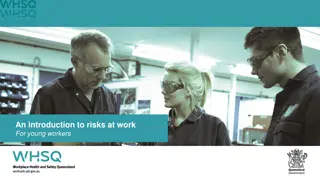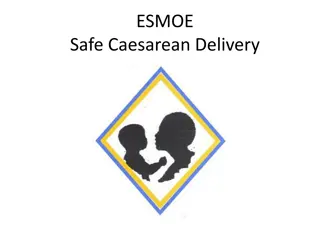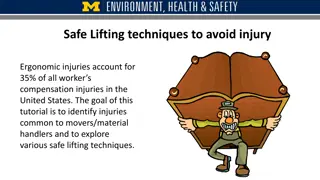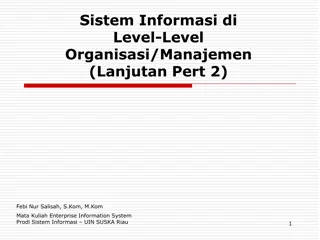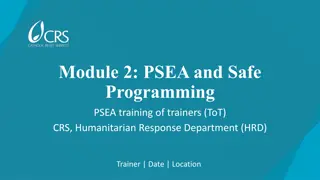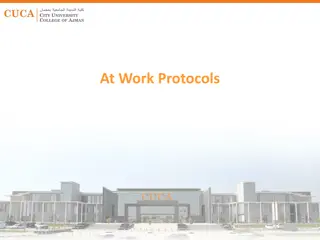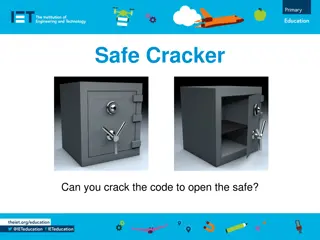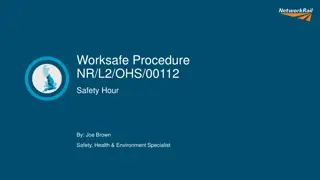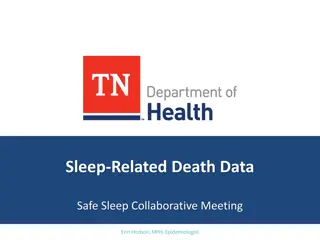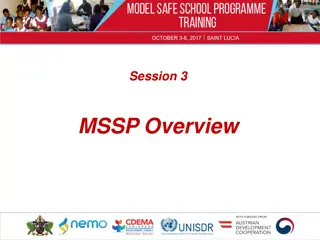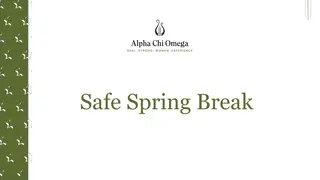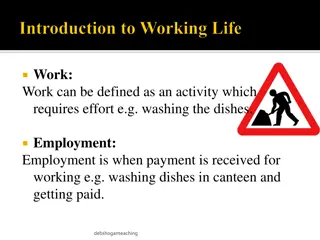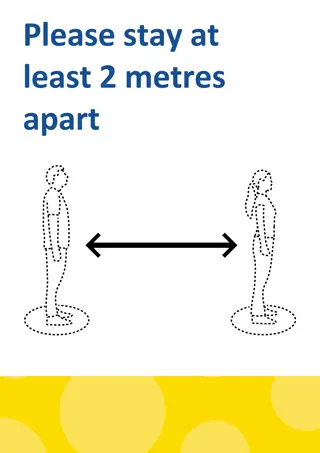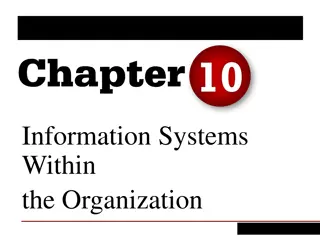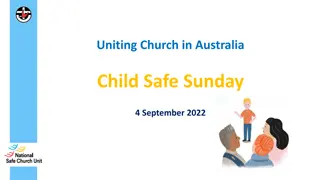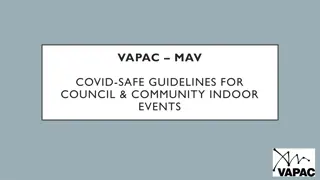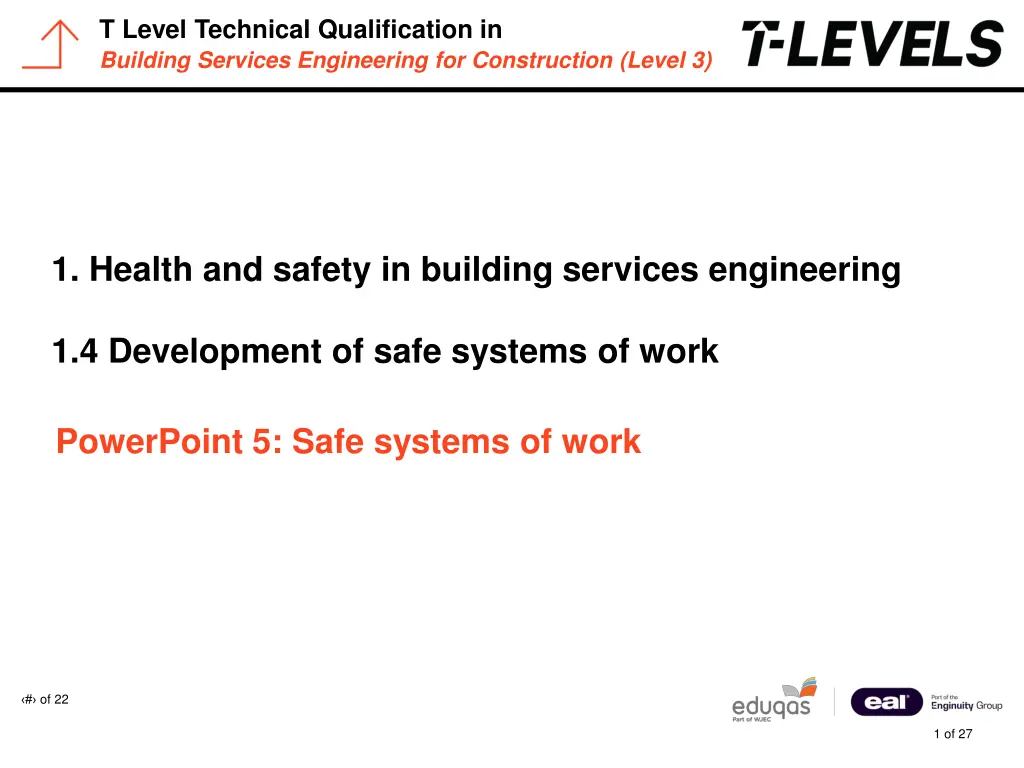
Developing Safe Systems of Work in Building Services Engineering
Learn about the importance of safe systems of work in construction, including risk assessments, method statements, COSHH assessments, and CDM requirements. Understand the significance of following safe practices to prevent accidents and ensure a high level of safety standards on-site.
Download Presentation

Please find below an Image/Link to download the presentation.
The content on the website is provided AS IS for your information and personal use only. It may not be sold, licensed, or shared on other websites without obtaining consent from the author. If you encounter any issues during the download, it is possible that the publisher has removed the file from their server.
You are allowed to download the files provided on this website for personal or commercial use, subject to the condition that they are used lawfully. All files are the property of their respective owners.
The content on the website is provided AS IS for your information and personal use only. It may not be sold, licensed, or shared on other websites without obtaining consent from the author.
E N D
Presentation Transcript
T Level Technical Qualification in Building Services Engineering for Construction (Level 3) PowerPoint presentation 1.4 Development of safe systems of work 1. Health and safety in building services engineering PowerPoint 5: Safe systems of work # of 22 1 of 27
T Level Technical Qualification in Building Services Engineering for Construction (Level 3) Objectives By the end of the session, learners should be able to: state how safe systems of work are developed and used understand the implications of not having safe systems of work in place complete risk assessments, method statements and COSHH assessments understand how to apply Construction Design and Management (CDM) understand the requirements for site signage state the different levels of the Construction Skills Certification Scheme (CSCS, SMSTS, SSSTS) understand the safe isolation of the different systems encountered in the BSE sector. # of 22 2 of 27
T Level Technical Qualification in Building Services Engineering for Construction (Level 3) Safe systems at work A safe system of work is a procedure to eliminate the risks that are involved in a specific operation. The priority of a safe system of work is to eliminate any risks involved with the work. In this presentation we look at how following the risk assessment process can reduce risks on site and ensure safe systems of work. It is vital that safe systems and practices are adhered to so that everyone is working to the same high safety standards at all times. Without these systems in place, accidents might occur that could cause injury or death. # of 22 3 of 27
T Level Technical Qualification in Building Services Engineering for Construction (Level 3) Method statements A method statement documents the logical process of how an operative intends to complete a task safely. It should complement an associated risk assessment and be written to negate any risks identified when completing any task. The method statement should provide logical steps and specific actions on how to complete the task, ensuring safety at all times. It also documents what control measures, personal protective equipment (PPE) or other safety resources are required so that the task can be completed safely. # of 22 4 of 27
T Level Technical Qualification in Building Services Engineering for Construction (Level 3) Risk assessments A risk assessment needs to be completed in order to: back up a manufacturer s data sheet for the Control of Substances Hazardous to Health Regulations (COSHH) assess various activities carried out by employees. As an employee, you must assess the risk to yourself and others when work is being carried out. This is the essence of working safety. After a risk assessment has been completed, it will, at minimum, result in the use of PPE and the presence of a first-aid kit. However, the more risk is identified in the assessment, the more mitigation processes need be in place to protect operatives and anyone else who may be affected by the work being completed. # of 22 5 of 27
T Level Technical Qualification in Building Services Engineering for Construction (Level 3) The five steps There are five steps to a risk assessment: 1.Look for hazards. 2.Decide who or what might be harmed. 3.Evaluate the risks, present precautions and act when needed. 4.Record your findings. 5.Review and revise your findings regularly. The Management of Health and Safety at Work Regulations 1999 legally require employers to make decisions about the hazards, significant or otherwise, faced in the workplace. # of 22 6 of 27
T Level Technical Qualification in Building Services Engineering for Construction (Level 3) Risk assessment: key definitions Accident: an unplanned, undesired occurrence which may result in harm or loss. Hazard: anything that has the potential to cause loss or harm. Risk: how likely is it that a hazard will actually cause harm or loss? When a risk assessment is put together, you have to identify the work hazard and calculate the likelihood of an accident happening. In this way you identify the risk rating. # of 22 7 of 27
T Level Technical Qualification in Building Services Engineering for Construction (Level 3) Risk assessment Risk rating Value of likelihood X Value of consequence No likelihood Very unlikely Unlikely Likely Very likely Certainty No injury or loss First aid Up to 3 days off work Over 3 days off work Major injury Fatality 0 1 2 3 4 5 0 1 2 3 4 5 Such assessments will always be examined by safety officers when performing inspections and may also be sought by insurance companies in the event of a claim. # of 22 8 of 27
T Level Technical Qualification in Building Services Engineering for Construction (Level 3) Risk assessment documentation # of 22 9 of 27
T Level Technical Qualification in Building Services Engineering for Construction (Level 3) COSHH COSSH stands for Control of Substances Hazardous to Health. The 2002 Regulations were introduced to control exposure to hazardous substances. The regulations explain any safety requirements when working with the following materials: solids eg soda crystals liquids eg bleach dust eg drilling through asbestos ceilings fumes eg when soldering vapours eg when solvent-cementing waste pipes gases eg flammable gases. # of 22 10 of 27
T Level Technical Qualification in Building Services Engineering for Construction (Level 3) COSHH data sheet Before using any substance always check the COSHH data sheet. You should then: conduct a risk assessment prior to use take precautions to minimise risk to health and establish if harm is caused by ingestion, inhalation or absorption introduce control measures to minimise risk further monitor levels of use and exposure to the risk on a regular basis. You must receive training on the use of the substance concerned and learn where it is possible to substitute a hazardous substance with a less harmful alternative. # of 22 11 of 27
T Level Technical Qualification in Building Services Engineering for Construction (Level 3) COSHH categories and symbols # of 22 12 of 27
T Level Technical Qualification in Building Services Engineering for Construction (Level 3) Domestic products and COSHH Remember that some domestic products can be hazardous. For example, loft insulation can be an irritant to the skin, domestic cleaning chemicals can be either acid or alkali (corrosive)and may burn the skin. The rule is that when using any item with a COSHH symbol: you need to wear gloves to protect your hands. # of 22 13 of 27
T Level Technical Qualification in Building Services Engineering for Construction (Level 3) CDM Regulations The Construction (Design and Management) (CDM) Regulations 2015: are intended to ensure health and safety issues are properly considered to minimise the risk of harm to everyone involved in a project set out definitions for principal designers, principal contractors and contractors. These are explained on the next slide. # of 22 14 of 27
T Level Technical Qualification in Building Services Engineering for Construction (Level 3) CDM definitions The principal designer (PD) is responsible for all the pre-construction phase planning and design work. The principal contractor (PC) must manage and coordinate the construction side of the project. The contractor (C) must plan and manage the work under their control, liaise with the PC and carry out the works without compromising health and safety. More information on the CDM Regulations 2015 can be found here: trusted-traders-guidance-for-businesses-434474.pdf (which.co.uk) # of 22 15 of 27
T Level Technical Qualification in Building Services Engineering for Construction (Level 3) Site safety signs Construction sites can be dangerous places, with hazards lurking around every corner. Construction site safety signs are designed to reduce the risk of accidents and injuries, protecting workers and members of the public. As well as pointing out hazards and pointing site users in the direction of urgent medical equipment, building site signs also play a crucial role in the efficient day-to-day running of the construction site. Employers have a legal responsibility to ensure that every site has the relevant construction signage. This is an essential step to reduce the incidence of workplace accidents and injuries and ensure that members of the public are aware of the location of prohibited sites. # of 22 16 of 27
T Level Technical Qualification in Building Services Engineering for Construction (Level 3) The four safety sign colours What are the four colours of safety signs? What are the categories of safety signs? Mandatory Information Prohibition Warning # of 22 17 of 27
T Level Technical Qualification in Building Services Engineering for Construction (Level 3) Prohibition signs Do not drink Do not touch No naked flames No access for pedestrians # of 22 18 of 27
T Level Technical Qualification in Building Services Engineering for Construction (Level 3) Warning signs Corrosive material Danger, electricity Flammable materials Trip hazard # of 22 19 of 27
T Level Technical Qualification in Building Services Engineering for Construction (Level 3) Mandatory signs Safety boots must be worn Eye protection must be worn Pedestrians walk this way Hard hats must be worn # of 22 20 of 27
T Level Technical Qualification in Building Services Engineering for Construction (Level 3) Emergency signs Emergency exit route Emergency eye wash First aid Emergency telephone # of 22 21 of 27
T Level Technical Qualification in Building Services Engineering for Construction (Level 3) Construction Skills Certification Scheme A Construction Skills Certification Scheme card proves that an individual has passed a health and safety test which enables them to work on a building site. The cards come in different colours which are in line with the level of qualifications held by the individual. Green construction site operative/labourer. Gold skilled worker (NVQ Level 3 qualified). Black senior manager (NVQ Level 4 qualified). Red trainee/apprentice. White individual with a construction-related job (eg cleaning of sites). # of 22 22 of 27
T Level Technical Qualification in Building Services Engineering for Construction (Level 3) SMSTS The Site Managers Safety Training Scheme (SMSTS) course is for project managers, site managers and supervisors, business owners and clients. The course covers: Health and Safety at Work Act (HASAWA) Construction Design and Management (CDM) Regulations risk assessments/method statements recent changes in accepted working practices behavioural safety management of occupational health # of 22 23 of 27
T Level Technical Qualification in Building Services Engineering for Construction (Level 3) SMSTS electricity excavations working at height scaffolding demolition confined spaces. # of 22 24 of 27
T Level Technical Qualification in Building Services Engineering for Construction (Level 3) SSSTS The Site Supervisors Safety Training Scheme (SSSTS) is for site supervisors and covers: Health and Safety at Work Act specific site issues that challenge supervisors on a daily basis effective toolbox talks supervision of occupational health behavioural safety. # of 22 25 of 27
T Level Technical Qualification in Building Services Engineering for Construction (Level 3) Any questions? # of 22 26 of 27

